The Solar System | Geology Optional for UPSC PDF Download
The Solar System: An Overview
The universe's vastness dwarfs the Earth, positioning it as a mere speck of dust orbiting a small star in a distant corner of the Milky Way galaxy. The universe, estimated to be about fifteen to twenty billion years old, far predates human existence, which began only around two million years ago. Within this ancient expanse, various celestial bodies populate the cosmos.
Our Solar System: A General Survey
- The Milky Way and the Solar System: The Milky Way galaxy contains roughly 100 billion stars, forming various systems like the Solar System. Our Solar System is a minute component of the galaxy, distinguished by its congregation of stars and planets.
- Components of Our Solar System: The Solar System consists of the Sun, eight planets (Mercury, Venus, Earth, Mars, Jupiter, Saturn, Uranus, and Neptune), their satellites, numerous smaller bodies like asteroids and comets, as well as dust grains and gases.
- Orderly Nature: The Solar System exhibits a structured arrangement:
- The Sun's Central Position: The Sun resides at the center of the Solar System, exerting gravitational influence over its celestial bodies.
- Planetary Orbits: The planets orbit the Sun counterclockwise in elliptical paths, with the ecliptic plane representing Earth's orbital plane.
- Terrestrial and Gas Giant Planets: The Solar System comprises rocky, metal-rich inner planets (Mercury to Mars) and gas giants (Jupiter to Neptune), primarily composed of hydrogen and helium, positioned farther from the Sun.
- Size and Orbit Differences: Outer planets are larger and have more expansive orbits compared to inner planets. Additionally, an asteroid belt separates inner and outer planets.
The Sun
At night, numerous stars adorn the sky, but during the day, only the Sun, the closest star to Earth, is visible. Ancient civilizations revered the Sun as the 'Head' of the universe, though it serves as the focal point of our Solar System.
- Sun's Characteristics: The Sun is a massive, gaseous celestial body positioned at the Solar System's center. Its physical attributes include:
- Radius: Approximately 1.391 million kilometers.
- Mass: About 2 x 10^33 grams, nearly 99.87% of the Solar System's total mass.
- Density: Mean density of 1.4 grams per cubic centimeter.
- Temperature: Surface temperature around 6000 Kelvin, with the core temperature reaching about 15 million Kelvin.
- Composition: Primarily composed of hydrogen (70%), helium (28%), and other elements (2%).
- Distance from the Milky Way: Approximately 30,000 light-years.
Physical characteristics of the Sun
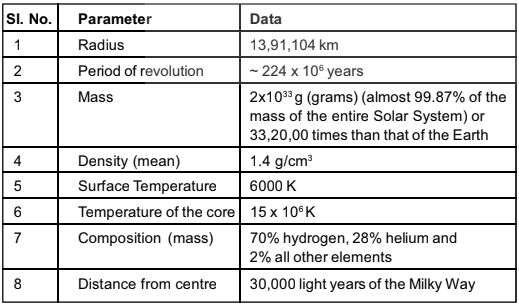
- Sun's Structure: The Sun consists of multiple layers, including the photosphere (visible surface), core (site of nuclear fusion), and corona (outermost layer of the atmosphere).
- Sun's Energy: The Sun generates energy through thermonuclear fusion reactions, where hydrogen nuclei fuse to form helium nuclei under extreme pressure and temperature conditions, akin to the process in a hydrogen bomb.
Understanding the intricacies of the Sun and the Solar System provides insights into the dynamics and marvels of our cosmic neighborhood.
The Planets
The arrangement of planets in our Solar System is depicted in Fig. 2.1, showcasing their order of increasing distance from the Sun. The eight planets orbiting the Sun are:
- Mercury (Buddha)
- Venus (Shukra)
- Earth (Prithvi)
- Mars (Mangal)
- Jupiter (Brihaspati)
- Saturn (Shani)
- Uranus (Arun)
- Neptune (Varun)
Jupiter and Saturn, the largest planets, contribute significantly to the overall mass of the Solar System. Apart from Mercury and Venus, most planets have moons orbiting around them, accompanied by numerous asteroids and comets encircling the Sun.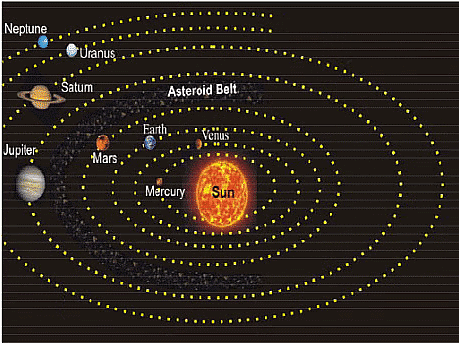
- Classification of Planets: The planets can be categorized into two groups:
- Inner Planets: Mercury, Venus, Earth, and Mars constitute the inner planets, positioned between the Sun and the asteroid belt.
- Outer Planets: Jupiter, Saturn, Uranus, and Neptune form the outer planets, situated beyond the asteroid belt.
The inner planets, also known as terrestrial planets, are predominantly rocky and metal-rich due to their formation in hot conditions close to the Sun. They lost much of their volatile materials due to solar radiation and solar winds, retaining dense metals like iron and rock-forming substances.
Conversely, the outer planets, termed Jovian or gas giants, primarily consist of hydrogen, helium, and other light constituents inherited from the original nebula. Despite having rocky cores akin to the Sun, their atmospheres are predominantly gaseous.
Each planet in the Solar System possesses unique characteristics:
Mercury: The closest planet to the Sun, Mercury is small and challenging to observe due to the Sun's glare. It appears briefly as a morning or evening object.
- Venus: Similar in size and density to Earth, Venus has a volcanic surface and distinct geological features, though lacking heavily cratered terrain.
- Earth: Uniquely known as the "blue planet," Earth harbors life and exhibits erosional and depositional features on its surface.
- Mars: Dubbed the "red planet," Mars showcases Earth-like characteristics, including ice caps, clouds, dust storms, and surface features like maria.
- Jupiter: The largest planet in the Solar System, Jupiter boasts a massive size and weight, with notable features like the Great Red Spot.
- Saturn: With its prominent ring system, Saturn is visually striking and ranks as the second-largest planet in the Solar System.
- Uranus: Exhibiting a distinct green hue due to methane and ammonia clouds, Uranus possesses a unique rotational axis tilted nearly perpendicular to its orbit.
- Neptune: Discovered in 1846, Neptune's distance from the Sun makes it appear as a bright point, and its largest moon, Triton, orbits in a direction opposite to the planet's rotation.
Physical characteristics of the planets of our Solar System
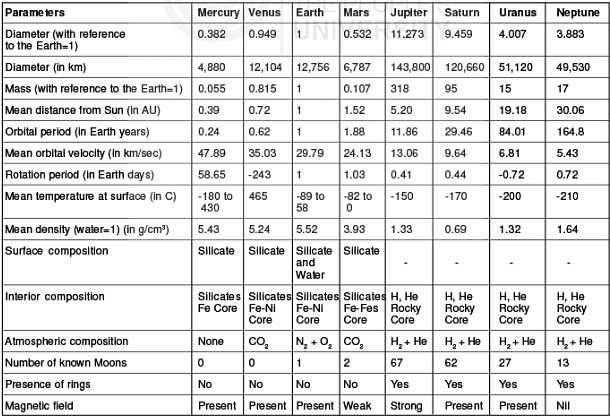
Asteroids, Meteorites, and Comets
The region between the orbits of Mars and Jupiter, spanning a distance of 547 million kilometers, hosts thousands of irregularly shaped minor planetary bodies comprising rocks and metals. These bodies, known as asteroids, range from tiny specks to hundreds of kilometers in size and are remnants of the original solar material that failed to coalesce into planets. Asteroids orbit the Sun within the asteroid belt, colliding and fragmenting over time.
- Asteroids: These rocky bodies orbit the Sun in the asteroid belt between Mars and Jupiter, ranging in size from dust particles to hundreds of kilometers in diameter.
As asteroids collide and disintegrate, some fragments enter Earth's atmosphere as meteors, producing streaks of light known as shooting stars. Meteoroids that survive atmospheric entry and impact the Earth's surface are termed meteorites. These meteorites, composed of iron, nickel, and rock-forming minerals, provide valuable insights into the composition of celestial bodies.
- Meteorites: Solid matter falling on Earth, the Moon, or other celestial bodies from space, classified into three groups based on their mineral composition: stony, iron, and stony-iron meteorites.
Comets, intriguing celestial objects, offer glimpses into the early history of the Solar System. Comets primarily consist of ices, including water ice along with frozen gases like methane, carbon dioxide, and ammonia, intermixed with dust particles. Some comets, like Halley's Comet, reappear at predictable intervals due to their elliptical orbits.
- Comets: Icy bodies orbiting the Sun, composed of a mixture of water ice, frozen gases, and dust particles, appearing as dirty snowballs.
Understanding the characteristics and behaviors of asteroids, meteorites, and comets enriches our knowledge of the dynamic processes shaping our Solar System.
Summary of the characteristics of asteroid, meteorites and comets
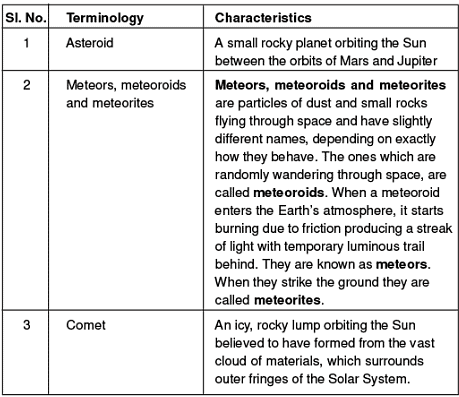
Universe And Solar System
Origin of the Universe:
- The universe is vast and believed to have no edge or center.
- Time and space were set at zero at the beginning.
- According to Einstein's theory of relativity, space and time are linked to form a continuum.
- The universe started as an infinitely small, hot, and dense state where matter and energy were compressed.
The Big Bang Theory:
- It's the most accepted explanation for the universe's origin and evolution.
- The theory describes a dense and hot state followed by expansion and cooling.
- The universe began around 14 billion years ago with a cosmic explosion.
- Matter and energy were compacted into a single dense point, and space itself exploded.
- As the universe expanded, matter and energy rushed apart, and the temperature dropped.
- Eventually, galaxies and stars formed from these expanding and cooling conditions.
Evidence for the Big Bang:
- The expanding universe: Galaxies are moving away from each other, suggesting an initial dense packing of matter.
- Background radiation: It's a leftover from the early universe and is considered the fading afterglow of the Big Bang.
Formation of the Solar System:
- Focus on the past 4.5 billion years for the evolution of our Solar System.
- Our Solar System consists of the Sun and the planets revolving around it.
- To understand Earth's formation, we need to understand how the Solar System formed.
Formation of the Solar System
Formation of the Solar System:
- Many theories proposed for the Solar System's formation, but Solar Nebula theory is widely accepted.
- Key features include the Sun, eight planets, one dwarf planet (Pluto), satellites, asteroid belt, comets, meteorites, and interplanetary dust.
- Chemical composition of the universe changed over time, evolving from 100% hydrogen and helium to 98% and 2% other elements.
Nebular Hypothesis:
- Proposed by German philosopher Kant, suggesting the Solar System originated from a rotating cloud of gas and fine dust called a nebula.
- Gravity caused the slow-rotating cloud to contract, increasing the rotation speed, similar to ice skaters pulling in their arms.
Formation of the Sun and Planets:
- As the universe expanded and cooled, stars and galaxies formed.
- The rotating gas cloud flattened into a disk, and the Sun formed in the center.
- Material gathered in eddies to form planets.
- Accumulated matter at the center formed the proto-Sun, which evolved into the present Sun through compression and nuclear fusion.
Timeline of Solar System Formation:
- Collapse and core formation of the nebula occurred around 5-5.6 billion years ago.
- Planets formed about 4.6 billion years ago.
- Inner planets (Mercury, Venus, Earth, Mars) are rocky, while outer planets (Jupiter, Saturn, Uranus, Neptune) are larger and less dense.
Composition Variations:
- Inner planets emerged as dense, rocky masses close to the Sun.
- Outer planets, with rocky cores, are mostly composed of hydrogen, helium, and light constituents from the original nebula.
- Composition changes with distance from the Sun.
Earth's Origin:
- As part of the Solar System, Earth formed about 4.6 billion years ago.
- The details of Earth's specific origin will be discussed later.
Origin of the Earth
Curiosity about the Earth's origins has driven human inquiry for centuries. Our current understanding of the Earth's formation has evolved through extensive research over time. In this section, we explore the various hypotheses and theories proposed by researchers to explain the origin of our planet.
Solar Nebula Hypothesis
The prevailing view among scientists is that the Earth and the Solar System originated from a massive nebula through planetesimal accretion and gravitational contraction. As the primitive Earth accumulated matter, gravitational compression and the decay of radioactive materials gradually heated the planet. This heat, trapped within the Earth, led to the melting of some constituents, resulting in the formation of distinct layers: a dense core, a mantle of less dense material, and an outer crust.
Hypotheses and Theories
Various hypotheses and theories have been proposed to explain the origin of the Earth, categorized into two groups: Uniparental or Monistic Hypotheses and Biparental or Dualistic Hypotheses.
- Uniparental or Monistic Hypotheses: These hypotheses propose a systematic evolutionary process from a single parent body. They include ideas from Kant, Laplace, Lockyer, Hoyle, Carl Weizacker, Herald Yuri, and Kuiper.
- Biparental or Dualistic Hypotheses: These hypotheses suggest the involvement of two parent bodies in Earth's formation, often related to explosive activities. Buffon, Chamberlin, Moulton, James Jeans, Jeffrey, Russell, Lyttleton, Banerjee, among others, support this view.
Several popular hypotheses have been proposed within these categories:
- Nebular Hypothesis of Kant: Immanuel Kant proposed in 1755 that the Solar System evolved from a rotating cloud of gases and dust, condensing into a single large rotating nebula, from which the planets, including Earth, formed.
- Nebular Hypothesis by Laplace: Laplace suggested in 1796 that the contraction and condensation of a gaseous nebula led to the formation of planets through the segregation of rings of gaseous matter.
- Planetesimal Hypothesis by Moulton and Chamberlin: Proposed in 1905, this hypothesis suggests that planets formed from filaments of hot gases pulled out from the Sun by the gravitational influence of another star.

Other theories include Jeans Tidal Theory, Jeffery Collision Hypothesis, Binary Star Hypothesis by H.N. Russell, and modern views like the Yuri-Kuiper Hypothesis and Fred Hoyle's Magnetic Theory. Additionally, the Big Bang Theory, proposed by George Gamow and detailed by Fred Hoyle and William Fowler, offers insights into the origin of the Universe and the elements within it.
Modern Views and Earth's Evolution
The Yuri-Kuiper Hypothesis suggests that a cloud of dust and gases condensed to form the ancestral Sun, around which eddies of varying sizes formed, eventually coalescing to form planetesimals and, ultimately, planets like Earth. The Earth's composition and structure underwent significant changes over time, transitioning from a homogeneous mass to a differentiated planet with distinct layers: core, mantle, and crust.

Various factors, including impacts from meteorites, gravitational compression, and heat from radioactive decay, contributed to the Earth's differentiation and the formation of its layered structure. Understanding these processes is essential for comprehending the Earth's geological evolution, which we delve into further in subsequent sections.
Shape and Structure of the Earth
The Earth's shape and structure have long intrigued humanity, with its diverse landscapes and hidden depths. While direct exploration is limited to the surface and atmosphere, scientists have used indirect methods, such as seismic studies, to understand the Earth's interior.
Physical Aspects
- Spherical Shape: The Earth is nearly spherical but slightly flattened at the poles and bulged at the equator due to its rotation. Mountains and valleys break the smooth curvature of the Earth's surface.
- Rotation and Revolution: The Earth rotates 360° daily and orbits the Sun once every 3651⁄4 days.
The Earth's parameters, including size, area, volume, density, mass, and relief, provide insight into its physical characteristics.
Parameters of the Earth relating to size, area, volume, density, mass and relief
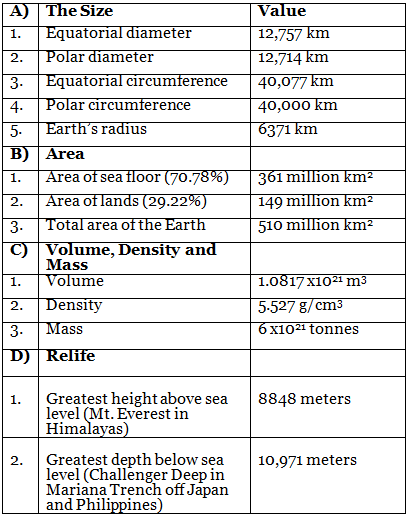
Surface Relief Features
- Continents: Covering 29.2% of the Earth's surface, continents exhibit varied relief, including plains, plateaus, and mountain ranges.
- Oceans: Spanning 70.8% of the Earth's surface, oceans feature canyons, seamounts, and trenches.
- Mid Oceanic Ridges: Raised features like the Mid Atlantic Ridge are found under the sea and give rise to islands.
Surface relief features vary in elevation, with low relief indicating relatively flat terrain and high relief showcasing elevated features like mountains and valleys.
Structure
The Earth's structure consists of several layers, with the crust, mantle, and core being the major ones. The crust, the outermost solid layer, varies in thickness and sits atop the mantle, a hot, partially molten layer. The core, the innermost part, is separated from the mantle by the Gutenberg discontinuity, with the Mohorovicic discontinuity marking the boundary between the crust and mantle.
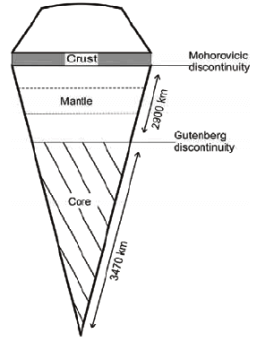
Understanding the Earth's structure is crucial for comprehending its geological processes and evolution, which we explore further in subsequent sections.
Age of the Earth
Understanding the age of the Earth is crucial for unraveling its geological history and the evolution of life on its surface. Geochronology, the science of Earth dating, employs various methods to estimate the age of rocks and fossils.
Age Determination of Rocks
Methods for determining the age of rocks can be categorized into indirect and direct methods, each offering unique insights into Earth's history.
- Indirect methods: These geological methods provide relative dating of events or features based on their position or characteristics relative to other geological entities.
- Direct methods: Radioactive methods offer absolute dating by measuring the decay of radioactive isotopes in rocks or minerals, providing specific numerical ages.
Geological Methods
i) Denudation or Sedimentation: This method is based on the fact that deposition has been going on in the basins right from the origin of the Earth. It was proposed that if total thickness of the sediments could be known and the rate of deposition could be found out then the age can be calculated by the following formula:

The age 510 million years by this method has been calculated since the beginning of Cambrian sedimentation.
ii) Salinity: In this method, it is presumed that the first f ormed seas did not have saline water. All the salts of the seas today have been acquired from continuous weathering and erosion of rocks that constitutes the land. It was proposed that if the salt present in the seas and its addition per year could be worked out then the age can be calculated. By this method, age of the Earth was calculated to be 100 million years by Jolly using the following formula:

iii) Glacial varves: Glacial varves are deposits generated due to combined action of river(s) and glacier(s). In summers, coarse grained material is deposited and in winters the deposition of fine grained material takes place. Each pair of coarse and fine material is called a varve and represents one year. Geological time upto 10,000 years has been calculated by counting such varves. This method has been used for the lake deposits of the Karewa basin in the Kashmir valley.
iv) Tree rings: Trees have their annual growth rings. Secondary growth rings of trees can be counted. Each pair of such rings represents one year. Time up to few thousand years can be calculated on the basis of such rings.
v) Palaeontological evidences: Charles Lyell in 1867 estimated age of the Earth on the basis of evolution of animals and plants. He found twelve cycles of evolution, each corresponding to twenty million years. However, this method could help in reaching to rough estimation of age after origin of life.
Radioactive dating relies on the decay of radioactive isotopes, such as uranium, thorium, potassium, rubidium, and carbon, into stable daughter isotopes at a constant rate. By measuring the ratio of parent and daughter isotopes in a sample, scientists can calculate the age of the material. Each radioactive isotope has a characteristic half-life, the time it takes for half of the parent material to decay into the daughter product.
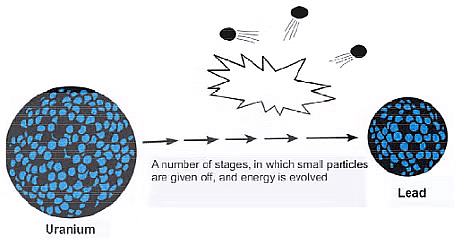
Radiocarbon dating, discovered by Willard Libby in 1949, is particularly useful for dating organic materials up to the Late Pleistocene period, providing valuable insights into the timing of ancient events and the evolution of life on Earth.
Radioactive series, with mother element, daughter element and half life period of main radioisotopes
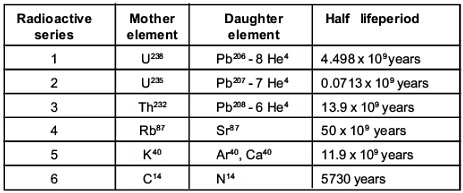
Calculation of Age
Understanding the age of the Earth involves various methods of calculation and analysis, providing valuable insights into the planet's geological history.
i) Uranium-Lead ratio method:
- The age of the Earth has been determined using the Uranium-Lead ratio method.
- Estimates suggest that the age of the present-day crust falls between 3500 and 5550 million years old.
ii) Measurement from meteorites:
- By measuring the Pb207 and Pb206 isotopes in meteorites, the age of the Earth has been estimated to be around 4500 million years old, assuming the amount of primordial lead in the crust is similar to that found in meteorites.
iii) Other dating methods:
- Additional methods, such as U-He (Uranium-Helium), K-Ar (Potassium-Argon), and Sr87/Sr86 dating of meteorites, have provided age estimates ranging from 4580 to 4520 million years.
iv) Radiometric dating:
- Based on radiometric dating techniques, it is concluded that the Earth's crust formed approximately 4.6 billion years ago.
These findings are crucial for understanding the geological evolution of the Earth and provide important constraints for modeling planetary formation processes.
|
64 videos|135 docs
|
FAQs on The Solar System - Geology Optional for UPSC
| 1. What are the main components of the Solar System? |  |
| 2. How are the planets in the Solar System classified? |  |
| 3. What is the origin of the Earth according to scientific theories? |  |
| 4. How old is the Earth estimated to be? |  |
| 5. What is the shape and structure of the Earth? |  |
















